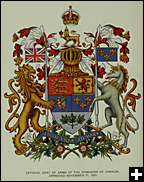Common menu bar links
The Arms of Canada
Armorial bearings owe their existence to the need of providing men with some mark of identification. They originated in the Middle Ages, when few men could read, but when all were trained to distinguish such symbols at a glance. Under these circumstances, the arms of the sovereign became generally identified with the arms of the nation, were emblazoned on shields and were later often incorporated into the national flag. In the case of England, the royal standard bears the Coat of Arms of the Sovereign, while the Union Jack or national flag is composed of the combination of the red cross of St. George on a white field, borne as their banner by the English from the time of the second Crusade, the white cross of St. Andrew on a blue field (Scotland), added in 1707, and the white cross of St. Patrick on a red field (Ireland), added in 1801.

Until 1921, the question of the Arms of Canada remained in an unsatisfactory position. In this country the Royal Arms, in their English form, have always been freely used. Soon after Confederation, when a Great Seal was required, a design approved by Royal Warrant of 26 May, 1868, displayed the arms of the four confederated provinces—Ontario, Quebec, Nova Scotia, and New Brunswick. This design, though not used for the Great Seal, was gradually adopted as the Arms of Canada. As the number of provinces increased, it became a common practice to add their arms to the original design. This resulted in overloading the shield with a multiplicity of detail, and a Committee, appointed to submit proposals, recommended the adoption of a coat of arms which has been approved by the Government and duly authorized, on November 21, 1921, by the King.
Three considerations were kept in view in determining the “achievement of arms,” i.e., the combination of arms, crest, supporters, and motto, which has now been authorized. These were: first, that Canadians stand to their King in as close a relation as do any of his subjects elsewhere; secondly, that Canada, an integral part of the British Empire, has emerged from the war a member of the League of Nations; and lastly, that Canada was founded by the men of four different races—French, English, Scottish and Irish—and that Canadians inherit the language, laws, literature and arms of all four mother countries.
The arms are those of England, Scotland, Ireland and France, with a “difference” to mark them as Canadian, namely, on the lower third of the shield, a sprig of maple on a silver shield.
The crest is a lion holding in its paw a red maple leaf, a symbol of sacrifice.
The supporters are, with some slight distinctions, the lion and unicorn of the Royal Arms. The lion upholds the Union Jack, and the unicorn the ancient banner of France.
The motto is new—“A mari usque ad mare”—“From sea to sea”, or, in a phrase familiar in Canadian politics and Canadian literature, “ocean to ocean”. It is an extract from the Latin version of verse 8 of the 72nd Psalm, which in the Authorized Version is: “He shall have dominion also from sea to sea, and from the river unto the ends of the earth.” The Latin reads: “Et dominabitur a mari usque ad mare, et a flumine usque ad terminos orbis terrarum.” There is a tradition that the Fathers of Confederation derived the designation “Dominion” from this verse.
